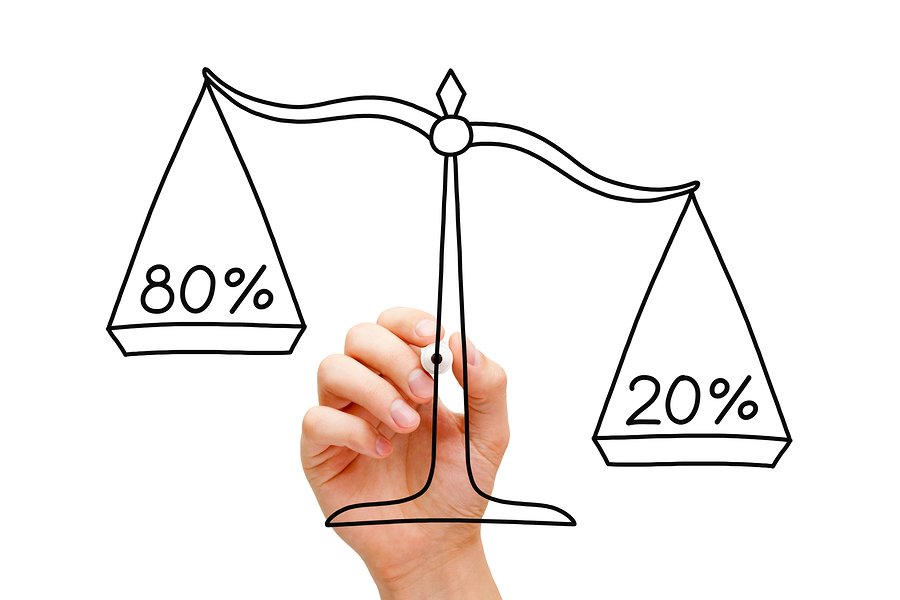The Pareto principle is definitely something familiar. Have you faced it within your work? What about the famous 80/20 ratio? There is no doubt that at least once in your life you have heard about the famous rule, described by Mr. Pareto.
According to one of the legends, 80% of the Mona Lisa’s portrait was painted in the first 20% of the time. But would it become a masterpiece without details? 80/20 is not a law of nature, its just an observation. This 80/20 ratio of cause-to-effect became known as the Pareto Principle.

Did you know that originally, the Pareto concept referred to the study that 80% of Italy’s wealth belonged to only 20% of the population?
Italian economist Vilfredo Pareto described this observation in 1906. The Italian also investigated different industries and found that 80% of production typically came from just 20% of the companies.
However, the work on this observation played a bad joke with the principle’s author: he became obsessed with this ratio, noticing it in everything. He even noticed that 80% of the peas in his orchard came from 20% of his pea plants.
What is the 80/20 rule about?
In general, the Pareto rule means observation, not a law. It about the idea that most things in our life are not distributed evenly.
Pareto principle definition
Therefore, the main idea about the Pareto rule is a prediction that 80% of effects come from 20% of causes.
This 80/20 rule can mean anything:
- 20% of the employees produce 80% of the results
- 20% of the product features cause 80% of the usage
- 20% of the customers create 80% of the revenue, etc.
However, be careful when using this concept, as there’s a common misconception that the numbers 20 and 80 must add to 100. They actually don’t.
You can take the Pareto’s 80/20 rule and apply it to almost any situation that many businesses do nowadays. This concept helps to learn how to prioritize tasks, objectives, days, weeks, and months and succeed.
Among the many complex and conceptual prioritization methods and techniques, this principle looks quite simple and accessible to everyone. It’s essential to business strategic planning that is one of the core qualities of managers and leaders.

Pareto principle: how does it work?
As you understand, the principle suggests two out of ten items, on any to-do list, will turn out to be worth more than the other eight items together.
How to apply it to goal setting?
One of the greatest ideas about effective goals and objectives is applying a popular SMART goals concept (setting goals in order to make them specific, measurable, achievable, relevant and time-bound).
The SMART goals concept + Pareto rule = boosting your overall productivity
You may simply take a piece of paper and write down ten relevant goals, asking yourself: “If I could accomplish only one of these goals today, which one would have the greatest impact on my life”?
Then choose the second most important goal and so on. After completing this easy exercise, you will define the most important 20% of your goals that will be most helpful than anything else.
Pareto rule in real life
We all dreaming big dreams. When we begin to dream big dreams, we feel more powerful about ourselves and our ability to deal with what happens to us. The reason so many people achieve so little is that they never allow themselves to imagine the kind of life that is possible for them.
So how to use Pareto’s principle to gain more time and be more productive?
- For executives. Executives constantly face the challenge of limited resources. The Pareto approach helps them to clearly understand which projects, goals, and tasks are most important and urgent. After applying the rule, they are able to delegate or drop the rest.
- For freelancers. One of the initial goals for any freelancer is to identify the best and highest-paying clients. Too much diversification leads to quick burnout. The 80/20 principle assists them to focus on earning money and strengthening long-term relationships.
- For entrepreneurs. There is always a temptation to try something new. But it often boils down to your goals. Perhaps, the 80/20 mindset is what you need to stay focused on your strategic plan and spend less time chasing endless new opportunities.
Pareto rule examples
In management
Many companies may agree that 80% of work is completed by 20% of team members. There is often a wide performance gap between your top performers and the rest of your team.
In software development
80% of software problems are caused by 20% of bugs. It’s about the typical picture in many IT companies, where the most crucial problems are caused by a couple of serious bugs.
In sales
Great performing salespeople are not easy to find. So, it’s rather logical that 80% of sales come from 20% of your salespeople.
In sports
There are also defined cases of using the Pareto principle in applying to sports and athletic training. They say, approximately 20% of the exercises have 80% of the impact and the trainee should not focus so much on varied training. It does not mean that your diet is not important, they just are not as significant as the key activities.
In healthcare
Healthcare professionals use the Pareto principle to underline the importance of hazard prioritization. 20% of the hazards account for 80% of the injuries. With the help of the approach, they can target that 20 % of the hazards.
The concluding idea about the Pareto rule is that it helps to define a good thing and avoid being a slave to a never-ending list of things to do.
How often do you use the Pareto principle for goal setting and other issues? What changes have you noticed?





